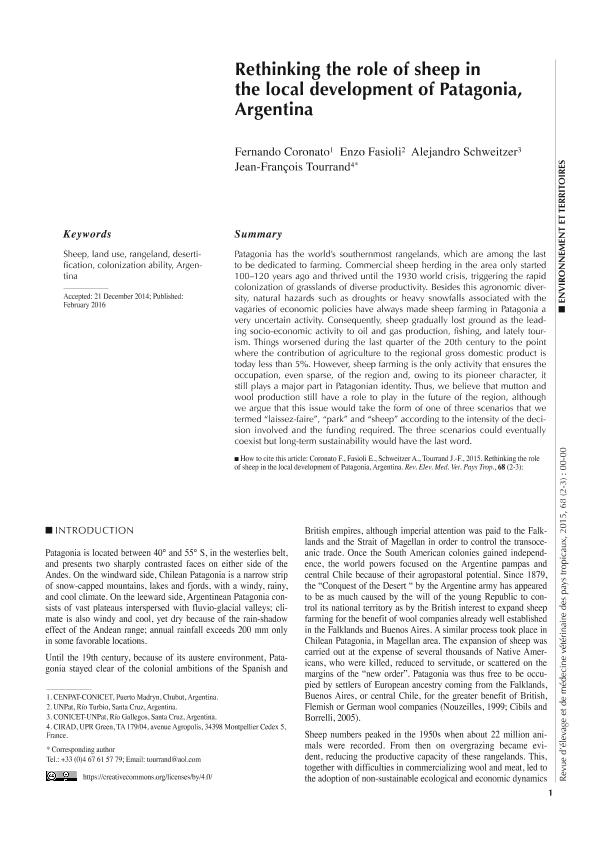Mostrar el registro sencillo del ítem
dc.contributor.author
Coronato, Fernando Raul

dc.contributor.author
Fasioli, Enzo

dc.contributor.author
Schweitzer, Alejandro Fabian

dc.contributor.author
Tourrand, Jean Francois

dc.date.available
2017-07-21T19:28:10Z
dc.date.issued
2016-03-25
dc.identifier.citation
Coronato, Fernando Raul; Fasioli, Enzo; Schweitzer, Alejandro Fabian; Tourrand, Jean Francois; Rethinking the role of sheep in the local development of Patagonia, Argentina; Cirad-centre Cooperation Int Recherche Agronomique Pour; Revue d’élevage et de médecine vétérinaire des pays tropicaux; 68; 2-3; 25-3-2016; 129-133
dc.identifier.issn
1951-6711
dc.identifier.uri
http://hdl.handle.net/11336/21110
dc.description.abstract
Patagonia has the world’s southernmost rangelands, which are among the last to be dedicated to farming. Commercial sheep herding in the area only started 100–120 years ago and thrived until the 1930 world crisis, triggering the rapid colonization of grasslands of diverse productivity. Besides this agronomic diversity, natural hazards such as droughts or heavy snowfalls associated with the vagaries of economic policies have always made sheep farming in Patagonia a very uncertain activity. Consequently, sheep gradually lost ground as the leading socio-economic activity to oil and gas production, fishing, and lately tourism. Things worsened during the last quarter of the 20th century to the point where the contribution of agriculture to the regional gross domestic product is today less than 5%. However, sheep farming is the only activity that ensures the occupation, even sparse, of the region and, owing to its pioneer character, it still plays a major part in Patagonian identity. Thus, we believe that mutton and wool production still have a role to play in the future of the region, although we argue that this issue would take the form of one of three scenarios that we termed “laissez-faire”, “park” and “sheep” according to the intensity of the decision involved and the funding required. The three scenarios could eventually coexist but long-term sustainability would have the last word.
dc.format
application/pdf
dc.language.iso
eng
dc.publisher
Cirad-centre Cooperation Int Recherche Agronomique Pour

dc.rights
info:eu-repo/semantics/openAccess
dc.rights.uri
https://creativecommons.org/licenses/by-nc-sa/2.5/ar/
dc.subject
Sheep
dc.subject
Land Use
dc.subject
Rangeland
dc.subject
Desertification
dc.subject.classification
Ganadería

dc.subject.classification
Producción Animal y Lechería

dc.subject.classification
CIENCIAS AGRÍCOLAS

dc.title
Rethinking the role of sheep in the local development of Patagonia, Argentina
dc.type
info:eu-repo/semantics/article
dc.type
info:ar-repo/semantics/artículo
dc.type
info:eu-repo/semantics/publishedVersion
dc.date.updated
2017-07-13T14:02:15Z
dc.journal.volume
68
dc.journal.number
2-3
dc.journal.pagination
129-133
dc.journal.pais
Francia

dc.journal.ciudad
Montpellier
dc.description.fil
Fil: Coronato, Fernando Raul. Consejo Nacional de Investigaciones Científicas y Técnicas. Centro Científico Tecnológico Conicet - Centro Nacional Patagónico; Argentina
dc.description.fil
Fil: Fasioli, Enzo. Consejo Nacional de Investigaciones Científicas y Técnicas; Argentina
dc.description.fil
Fil: Schweitzer, Alejandro Fabian. Consejo Nacional de Investigaciones Científicas y Técnicas; Argentina
dc.description.fil
Fil: Tourrand, Jean François. CIRAD; Francia
dc.journal.title
Revue d’élevage et de médecine vétérinaire des pays tropicaux
dc.relation.alternativeid
info:eu-repo/semantics/altIdentifier/url/http://remvt.cirad.fr/cd/derniers_num/2015/REMVT15_129_133.pdf
Archivos asociados
